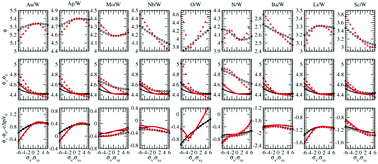Adsorbate induced modulation of strain effects on work functions of a tungsten (100) surface
Abstract
The effects of strain on the work functions of tungsten surfaces covered with a monolayer of adsorbates have been studied systematically using ab initio density functional theory. It has been found that the strain on tungsten surfaces due to different atomic coverages exhibits very interesting influences on the surface work function. For a clean tungsten surface, a compressive strain more profoundly increases the work function than a tensile strain, and the strain dependence of the work function shows a concave trend. With an atomic coverage of adsorbates, the strain dependence of the work function on the tungsten surface can be dramatically changed or modulated to a linearly increasing, linearly decreasing, convex, or sinusoidal behaviour, depending on the types of atoms. Using the framework of the well-developed surface dipole model [Phys. Rev. B, 2003, 68, 195408], the result of modulation of strain effects on the work function induced by different adsorbates can be well understood and attributed to two contributions, one from the relaxation of the substrate induced by the overlayer and the other from the surface dipole moment. These contributions are strongly correlated with the interlayer distances modulated by the adsorbates and strains. It is found that the O adsorbate-induced modulation of the strain effect on the work function exhibits a strong linear dependence on a uniaxial strain, and this may have applications in reducing the work function of cathodes by applying an external strain.



 Please wait while we load your content...
Please wait while we load your content...